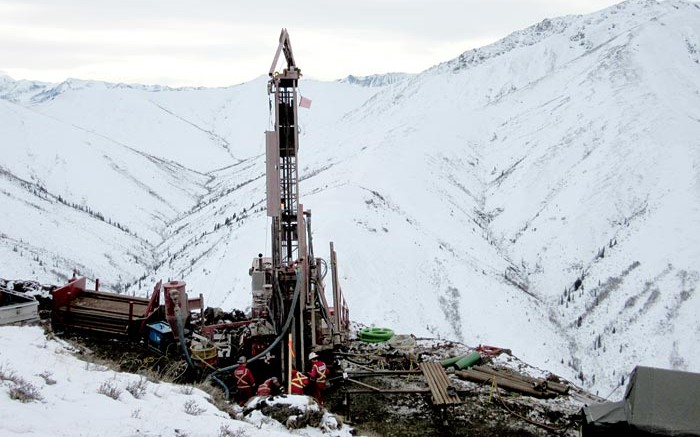Wellgreen Platinum (TSX: WG; US-OTC: WGPLF) has delivered an updated preliminary economic assessment (PEA) for its Wellgreen platinum group metals and nickel deposit, in the southern Yukon, that cuts capital costs and the project’s mine life while maintaining “robust economics.”
Total capital costs for the project still ring in at $1.5 billion, but initial capex is now forecast at $586 million (including $100 million in contingencies). That’s a nearly $300-million improvement over the $880-million initial capex predicted in a 2012 PEA.
The previous study had put life-of-mine capex at just shy of $2 billion.
The new study looks at a more modest, scalable operation with a 25-year mine life (down from 37 years).
As for economics, the project’s after-tax net present value (NPV) using a 7.5% discount rate is estimated at $1.2 billion ($2.1 billion before taxes) and its internal rate of return (IRR) at 24.6% (32.2% before taxes). Payback is projected at 3.2 years.
In a press release, Wellgreen’s president and CEO, Greg Johnson, said the study shows the project’s potential to become one of the lowest-cost open-pit PGM-nickel mines in the world.
The study pegs life-of-mine operating costs at $19.88 per tonne (down from $33.04 in the 2012 PEA) and all-in sustaining costs at US$457 per oz. 3E (42% platinum, 51% palladium and 7% gold) on a co-product basis with base metals.
“These results show a robustly economic project at conservative metal prices and an expected base-case mine life of 25 years, using only one-third of the pit-constrained mineral resources,” Johnson said.
“Given the technical and socioeconomic challenges faced by PGM mines in southern Africa and Russia, which currently account for over 90% of global PGM production, the development of an open-pit amenable, road-accessible PGM and nickel project in the mining-friendly Yukon Territory represents a truly unique opportunity for our company and our shareholders.”
The PEA envisions a scalable operation at Wellgreen, starting at 25,000 tonnes per day for the first five years and rising to 50,000 tonnes per day for 20 years.
Average annual production at Wellgreen, which was mined for several years by Hudbay Minerals in the 1970s, is forecast at 208,800 oz. 3E.
The mill would produce a bulk nickel-copper-cobalt-PGM-gold concentrate through conventional sulphide flotation that would be shipped to a smelter using existing deep-sea ports south of the project in Alaska.
While Wellgreen would be a mostly open-pit mine, there would also be some selective higher-grade underground mining.
The company is working out the costs and other details (such as the amount of drilling) needed to move forward with a prefeasibility study, which Wellgreen is aiming to complete in the first half of 2016. On a conference call, Johnson said the work would likely cost at least $10 million to $15 million.
Although the PEA outlines a base-case mine life of 25 years, existing resources offer the potential to expand the mine life by another 30 years.
The company could also boost Wellgreen’s economics by quantifying rare PGMs such as rhodium, iridium, osmium and ruthenium, which exist at the project and were recovered when the project was mined by Hudbay. Including these exotic metals, which are not in the current resource, could boost the PGMs reporting to concentrate by 10–13%.
Metals prices are currently lower than the base case prices used in the study, including US$1,450 per oz. platinum; US$800 per oz. palladium; US$1,250 per oz. gold; US$8 per lb. nickel; US$3 per lb. copper; and US$14 per lb. cobalt.
But even using the much lower spot prices as of the end of 2014, the economics hold up reasonably well. The after-tax NPV declines to $690 million ($1.3 billion before taxes) and the IRR falls to 18% (23.3% before taxes). The payback rate increases to 6.9 years.
The study was based on a July 2014 pit-constrained resource of 330 million measured and indicated tonnes grading 1.67 grams per tonne platinum equivalent, or 0.4% nickel equivalent; plus 846 million inferred tonnes grading 1.57 grams platinum equivalent per tonne, or 0.4% nickel equivalent. The estimate used a cut-off grade of 0.57 gram platinum equivalent per tonne, or 0.2% nickel equivalent.
Wellgreen had more than $10.5 million in its treasury at the end of 2014.
The company’s shares recently traded at 58¢ in a 52-week range of 45.5¢ to 97¢. Wellgreen has 112.4 million shares outstanding.


Be the first to comment on "Wellgreen Platinum scales down PGM project"